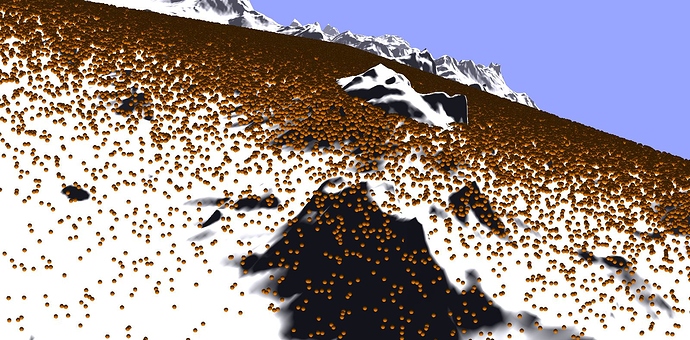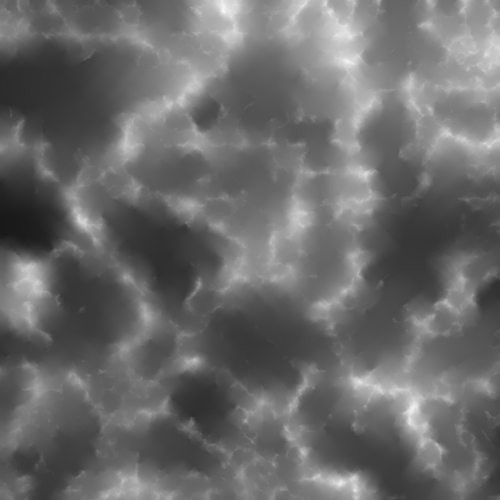Hello i want to add in my terrain 3d grass and tree, i can greate 100000 tree with very good performance but how can i get height of terrain for add into terrain my 100000 grass and trees ?
i have this code :
from direct.showbase.ShowBase import ShowBase
from panda3d.core import ShaderTerrainMesh, Shader, load_prc_file_data
from panda3d.core import SamplerState
from panda3d.core import GeomVertexFormat, GeomVertexData, GeomVertexWriter
from panda3d.core import Geom, GeomPoints, GeomNode, NodePath
from panda3d.core import TextureStage, TexGenAttrib, TransparencyAttrib
from panda3d.core import AmbientLight, DirectionalLight, Vec4
from random import uniform
class ShaderTerrainDemo(ShowBase):
def __init__(self):
# Load some configuration variables, its important for this to happen
# before the ShowBase is initialized
load_prc_file_data("", """
textures-power-2 none
gl-coordinate-system default
window-title Panda3D ShaderTerrainMesh Demo
""")
# Initialize the showbase
ShowBase.__init__(self)
# Increase camera FOV as well as the far plane
self.camLens.set_fov(90)
self.camLens.set_near_far(0.1, 50000)
# Construct the terrain
self.terrain_node = ShaderTerrainMesh()
# Set a heightfield, the heightfield should be a 16-bit png and
# have a quadratic size of a power of two.
self.terrain_node.heightfield = self.loader.loadTexture("heightfield.png")
# Set the target triangle width. For a value of 10.0 for example,
# the terrain will attempt to make every triangle 10 pixels wide on screen.
self.terrain_node.target_triangle_width = 10.0
# Generate the terrain
self.terrain_node.generate()
# Attach the terrain to the main scene and set its scale. With no scale
# set, the terrain ranges from (0, 0, 0) to (1, 1, 1)
self.terrain = self.render.attach_new_node(self.terrain_node)
self.terrain.set_scale(1024, 1024, 100)
self.terrain.set_pos(-512, -512, -70.0)
# Set a shader on the terrain. The ShaderTerrainMesh only works with
# an applied shader. You can use the shaders used here in your own application
terrain_shader = Shader.load(Shader.SL_GLSL, "terrain.vert.glsl", "terrain.frag.glsl")
terrain_shader = Shader.load(Shader.SL_GLSL, "terrain.vert.glsl", "terrain_tex_f.glsl")
self.terrain.set_shader(terrain_shader)
self.terrain.set_shader_input("camera", self.camera)
# Shortcut to view the wireframe mesh
self.accept("f3", self.toggleWireframe)
self.setBackgroundColor(0.6, 0.65, 1.0)
# render-to-texture stuff
altBuffer=self.win.makeTextureBuffer("spritebuf", 256, 256)
altRender=NodePath("alt render")
altCam=self.makeCamera(altBuffer)
altCam.reparentTo(altRender)
altCam.setPos(0.25, -12, 0)
teapot=loader.loadModel('models/jack')
teapot.reparentTo(altRender)
teapot.setPos(0, 0, -1)
self.accept("v", self.bufferViewer.toggleEnable)
self.bufferViewer.setPosition("llcorner")
self.bufferViewer.setCardSize(1.0, 0.0)
# lighting
dlight = DirectionalLight('dlight')
alight = AmbientLight('alight')
dlnp = altRender.attachNewNode(dlight)
alnp = altRender.attachNewNode(alight)
dlight.setColor(Vec4(0.8, 0.8, 0.5, 1))
alight.setColor(Vec4(0.2, 0.2, 0.2, 1))
dlnp.setHpr(0, -60, 0)
altRender.setLight(dlnp)
altRender.setLight(alnp)
# vertex writer
vdata = GeomVertexData('points', GeomVertexFormat.getV3(), Geom.UHDynamic)
vwriter = GeomVertexWriter(vdata, 'vertex')
#randomly generated vertex coordinates
number = 100000
for i in range(number):
vwriter.addData3f(uniform(-200,200), uniform(-200,200), uniform(0,0))
# create geom
points = GeomPoints(Geom.UHDynamic)
points.addNextVertices(number)
points.closePrimitive()
geo = Geom(vdata)
geo.addPrimitive(points)
gnode = GeomNode('points')
gnode.addGeom(geo)
np = render.attachNewNode(gnode)
# point sprite effect
np.setTransparency(TransparencyAttrib.MDual)
np.setTexGen(TextureStage.getDefault(), TexGenAttrib.MPointSprite)
np.setTexture(altBuffer.getTexture())
np.setRenderModeThickness(32)
ShaderTerrainDemo().run()
and i have this :
i need to modify this loop for :
for i in range(number):
vwriter.addData3f(uniform(-200,200), uniform(-200,200), uniform(0,0))
and replace -200 200 by the real height of terrain, but how ? thanks for advance


